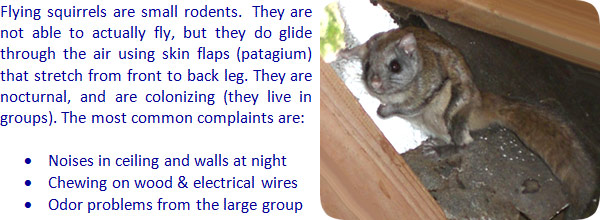- info@wildlifeanimalcontrol.com
Call us for help in your town
Wildlife Control Education
How to Catch a Flying Squirrel in Your House

Need flying squirrel removal in your hometown? We service over 500 USA locations! Click here to hire us in your town and check prices - updated for year 2020.
Squirrels are cute creatures that have a natural sense of curiosity and independence. However, flying squirrels that make their way into your attic can be very noisy between sunset and sunrise. They will also chew on your wires and insulation causing extreme damage and in some cases; fire.
When you have one or more flying squirrels in your attic, you will need to get rid of them as soon as possible. There are many humane methods for how to catch a flying squirrel. Catching flying squirrels can be very time consuming and frustrating. This causes some people to prefer to contact your local humane society or wildlife rescue department, as opposed to doing it themselves. Most people want to humanely capture a flying squirrel. If you contact an exterminator, you should inquire if they use a humane capture and release method, or a poison.
Also, you should contact your local wildlife capture to inquire about the state regulations for capturing and releasing flying squirrels. Some states will require the homeowner to obtain a special license to allow them to capture and release a flying squirrel. They may also have regulations regarding where the flying squirrel is allowed to be released.
We can answer: Will repellents keep flying squirrels out of the attic?
If you decide that you would prefer to catch and remove the flying squirrel on your own, the best method may be to use a live trap. The most popular trap for catching a flying squirrel is a single trap that is 18” x 5” x 5” with a grid that is a half inch. These types of trap have a single automatic door to provide users with a trap that is almost escape proof. The trap should be set in a place where the flying squirrel conducts the most activity. Search your attic for spots where the squirrel may have chewed. Also, look around for squirrel droppings. This will usually be a good indication of where the flying squirrel spends most of its time.
Some trappers recommended pre-baiting the trap. To complete a pre-bait, you will need to wire the automatic trap door so that it remains open when the squirrel glides into it. Place bait inside of the trap for a few days to allow the flying squirrel to become more accustomed and confident of the trap. Most of the time, a pre-bait technique is not needed.
There are many things that you are able to use to bait your live trap. Some of the bait can include a piece of bread with peanut butter spread on it, apples, grains, sunflower seeds, or fruit. A popular technique for baiting a trap is by scattering the sunflower seeds around the area and creating a trail to the inside of the trap.
Learn more: About Flying Squirrels
Once you have captured your flying squirrel, you should always keep in mind that you should never touch the squirrel outside of the trap. Flying squirrels are known to carry disease, fleas and ticks. You should always wear work gloves that are heavy duty to protect your hands from squirrel bites or scratches. After you have caught the flying squirrel, you should place a towel or a blanket over the trap. This will cause the squirrel to have less vision, making transporting the flying squirrel less hectic.
It is recommended that you release the flying squirrel at least four or five miles away from your home in a wooded area as they may find their way back to your attic. Once you have rid your attic of squirrels, you will need to take measures to ensure that they are unable to find their way back in.
Flying squirrels do not actually fly; they glide from the tree to your roof and into your attic. You should make sure that all of your tree lines that may hang over your roof are trimmed back. You should also repair any holes and cracks in the roof as flying squirrels have a skin texture that allow them to fit into tight ceiling cracks.
You should also make sure that you remove all of the birdseed and birdfeeders from your lawn. This attracts a squirrel. When you remove their source of food, they may leave on their own to search for a new supply.
More in-detail how-to flying squirrel removal articles:
Information about flying squirrel trapping - analysis and methods for how to trap.
Information about how to kill a flying squirrel - with poison or other methods.
Information about how to keep flying squirrels away - prevention techniques.
Information about flying squirrel repellent - analysis of types and effectiveness.
This site is intended to provide information about how to catch a flying squirrel, so that you can make an informed decision
if you need to deal with a flying squirrel problem. This site provides many flying squirrel capture articles and strategies, if
you wish to attempt to solve the problem yourself. If you are unable to do so, which is likely with many
cases of flying squirrel removal, please go to the home page and click the USA map, where I have wildlife removal experts
listed in over 500 cites and towns, who can properly help you with your nuisance flying squirrel.
Click here to
read more about how to get rid of flying squirrels.

















